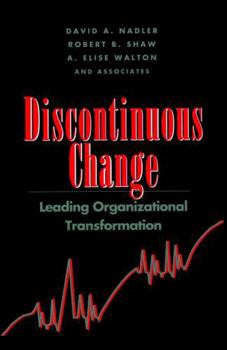Discontinuous Change: Leading Organizational Transformation
Select Format
Select Condition 
Book Overview
Explores the practical lessons learned from internationally renowned companies to bring about lasting and fundamental organizational transformation, providing a useful set of field-tested concepts and techniques for anyone seeking to promote change. In-depth interviews with such key corporate change leaders as Bob Allen of AT&T and Jamie Houghton of Corning, Inc., provide valuable insight and firsthand advice on the role CEOs and leadership teams...
Format:Hardcover
Language:English
ISBN:0787900427
ISBN13:9780787900427
Release Date:December 1994
Publisher:Jossey-Bass
Length:320 Pages
Weight:1.10 lbs.
Dimensions:1.2" x 6.5" x 9.2"
Customer Reviews
3 ratings
Inspirational
Published by Thriftbooks.com User , 24 years ago
Introduction In the book Discontinuous Change the authors use anecdotes of prestigious organizations to enhance the understanding of the theoretical and practical ideology concerning organizational change. The authors begin the text by identifying the precursors of organizational change. The precursors are shifts in industry structure, technological innovation, macroeconomic trends and crises, regulatory or legal changes, market and competitive forces and growth. The authors introduce the concept of sustained success as arrogant, insular, and complacent. By remaining in the sustained success idealism, the authors state that the organization will fall into the trap of success which tends to lead to an internal focus; the perception that knowledge, insight, and ideas are found inside the organization rather than outside. Throughout the text, the authors create a clear distinction between incremental and discontinuous change. The authors define incremental change as a continuous pattern of large and small changes that may impact the functioning enterprise in small or large increments. In contrast, discontinuous change is defined as a shocking impact that creates radical departure from the past. Using a variety of models, the authors give the reader a visual picture of the types of change that could occur in an organization. Portrayed in one of the models, the reader will identify the leadership as the "champions and gatekeepers" of the change. By setting the pace, the leaders identify the new corporate identity, the degree to which change needs to happen, the design and organization of the change plan and the interventions needed to keep the plan on course. The authors conclude with discussions concerning the different types of leaders that have been involved with organizational change throughout the years. The authors identified three types of leaders, heroic, instrumental and institutionalized. The authors concluded that the institutionalized leader would be more effective in directing the discontinuous change. Gut Reactions The authors believe that the organizational change should begin with the senior management, by analyzing their "point of view" relative to organizational strategy and policy level. In addition, they also focus on the behavioral dynamics of the organization, believing that the organization is a complex yet active system of human behavior. As practitioners, the authors give valuable insight for contemporary use in organizational change. Citing large organizations, such as, AT & T, Chrysler, and GE as examples, the authors state that the need for change in these organizations came from life-threatening business issues not just questions of organizational work life or corporate climate. In addition, the authors state that the issues that arose in the organizations were generated from external sources, such as, competition, new technology, deregulation, maturation of product sets, changes in ownership, shifts
"Change 101"
Published by Thriftbooks.com User , 24 years ago
One of the very best books read for my graduate degree. Nadler and Shaw point out that only those companies able to respond quickly and effectively to changing environmental conditions will survive in the coming decades. Successful firms must learn and act at a faster rate than their competition. Many leaders can affect some change in an organization-but it is normally short lived. But, to make change more long term and make that change take place at a faster rate-you must create destabilizing events in significant scope to get attention-and keep it! There are many take-aways in this book. If you want an outstanding "Leadership 101" book in 276 short pages-this is the one you want.
Enlightening, sometimes dry...
Published by Thriftbooks.com User , 25 years ago
Have you ever closed a book after finishing the last page and wondered how you might apply all that you've learned from its contents? By the same token, have you ever struggled through a book which you knew had great information and yet its presentation left a dry, chalky feeling in your head?If not, then this book is for you. I found it to be very enlightening and the book gave clear examples of organizations which either failed to anticipate change or proactively sought to position itself for change. Nadler, et al, break down the stages of change management into readable bites and provide stepping stones of the thought processes that should be involved in change management.Even better, the authors discuss how the corporate culture is directed by leadership's attitude towards change and covers how to bring about change in spite of internal resistance.That said, this is tough stuff to dig into for any length of time.






